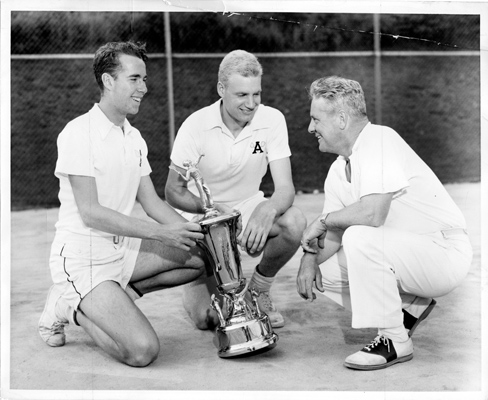By Ed Wesely ’52
[1952] Phew! We didn’t know it at the time, but Amherst tennis was in transition in 1952. We practiced on venerable (if dusty) courts, now vanished from a shelf above Hitchcock Field. We hit white tennis balls with wooden racquets, standard ensembles since the 1880s.

From left, Ed Wesely, David Mesker and Coach Frank Gillespie with the sought-after NEI trophy. “We never played harder, or with more determination, than we did that weekend,” writes Wesely.
Early that spring we’d beaten top players from Yale, Harvard and visiting North Carolina in team matches, and we’d go on to defeat Williams to win the Little Three title. But our proudest moments were spent on Yale’s clay courts in late May, as we played in tense matches to retire an eight-point Challenge Trophy.
The trophy was the prize for earning eight points in the New England Intercollegiate Championship, which took place over a spring weekend each year. A scoring rule, adopted in 1900, awarded schools one point for winning a singles or doubles competition and half a point for being a runner-up. Schools carried points from one year to the next, but they accumulated slowly, even for the most talented teams.
Dartmouth won the first Challenge Trophy in 1911 and Williams the second in 1923. Entering the 1952 tournament, the 15th year of competition for trophy number four, Amherst and Williams each held seven and a half points.
“Phew” is the best way I can describe the championship weekend—which, for me, meant playing 16 sets of tennis. We’d play a match, find a soft drink or candy bar, replace dusty socks and be called again.
Late Saturday David Mesker ’53 and I warmed up for a semi-final match against Williams that would seal the trophy’s fate. The Williams players began strongly and were soon serving at 6-0, 5-4, and two points from winning.
David made vital shots in this game, and after a slow start I perked up. Eventually we broke Williams’ serve, got clicking and dictated the rest of the match. Sunday we beat Yale handily and brought the trophy home.
The Amherst Student announced, “Amherst Retires 8-Point Trophy,” and the headline is apt, because success was cemented by all 1952 teammates, and by earlier players, too: Tom Rodman and Wyly Lamar, 1941 doubles winners; Bruce Daniels and Chuck Keevil, 1948 doubles champs; and especially Bill Smith ’51, whose three New England Intercollegiate singles championships put the trophy within reach.
Mindful of this legacy, we never played harder, or with more determination, than we did that weekend.
I recall, too, how much fun we had during the season, joking about how to “stay loose” in blustery April wind or when dusted by snow at Dartmouth. We build camaraderie that’s kept us writing, visiting and smiling for six decades. k
Ed Wesely ’52, tennis team captain his senior year, rears and releases monarch butterflies (more than 7,000 at last count) in Wayne County, Pa.
Photo by Curtis L. Barnes Jr., Amherst College